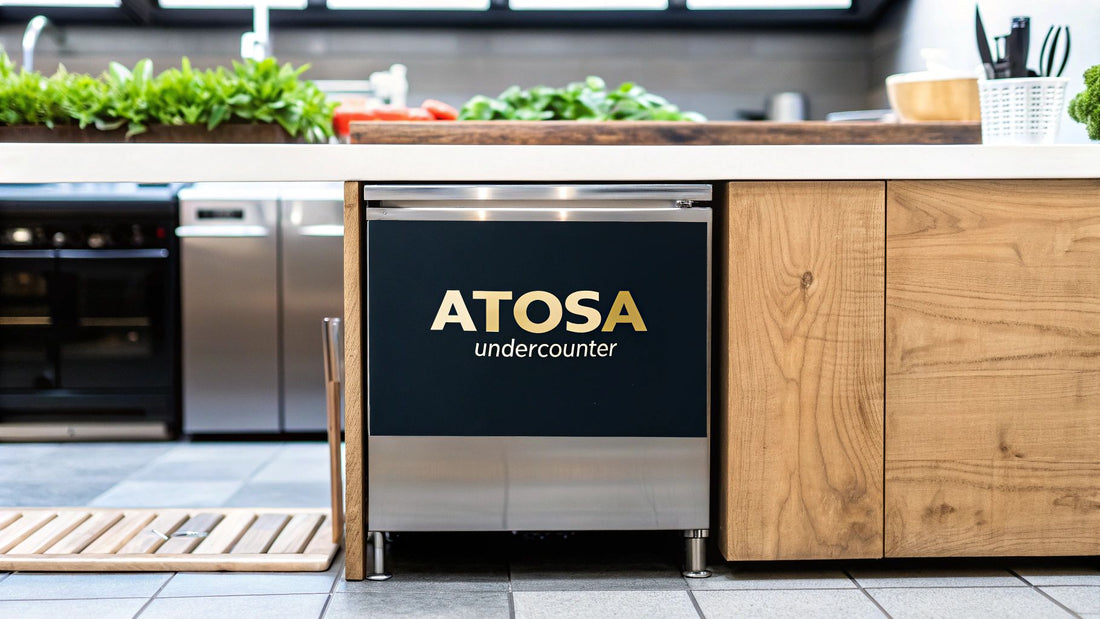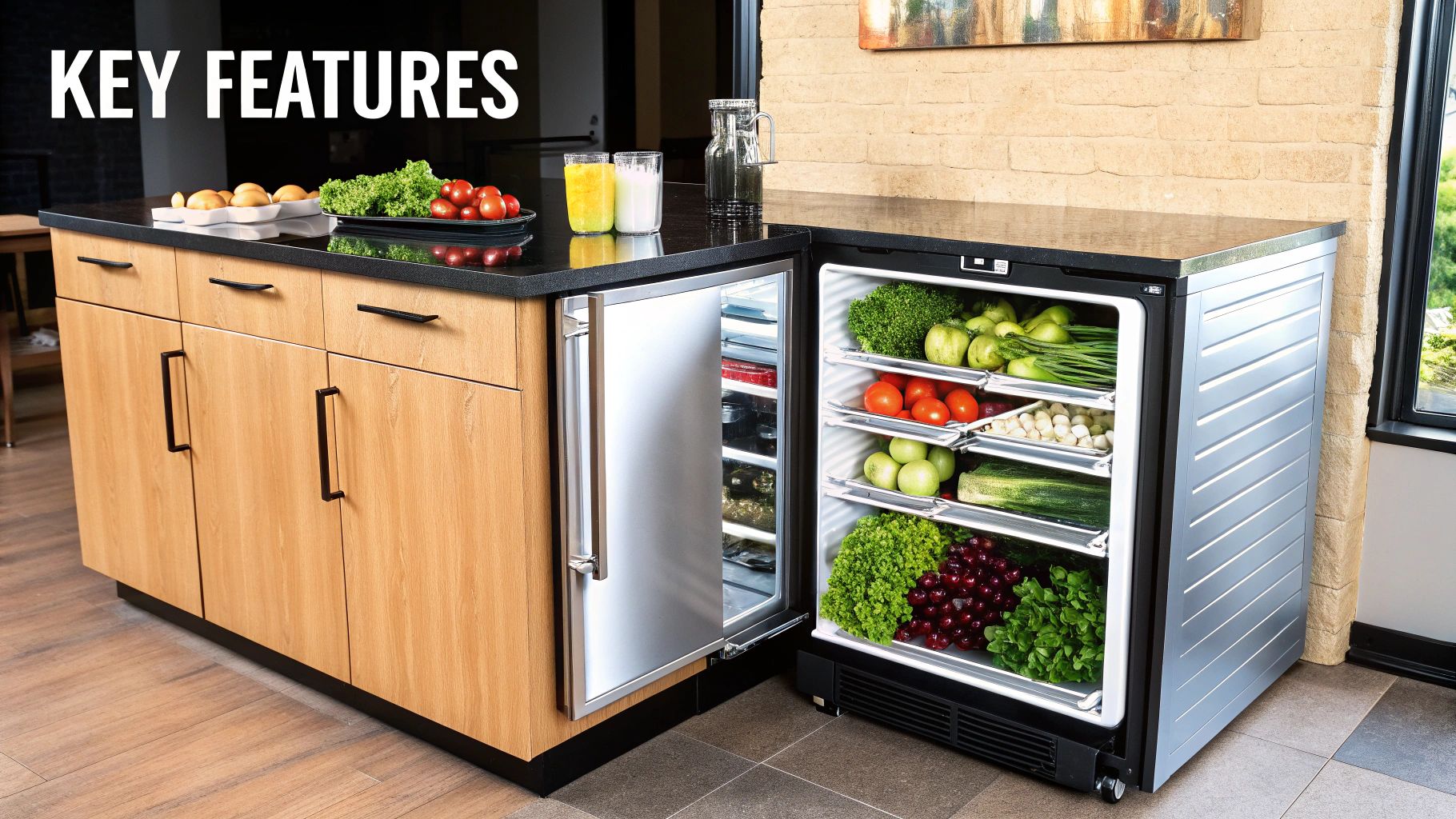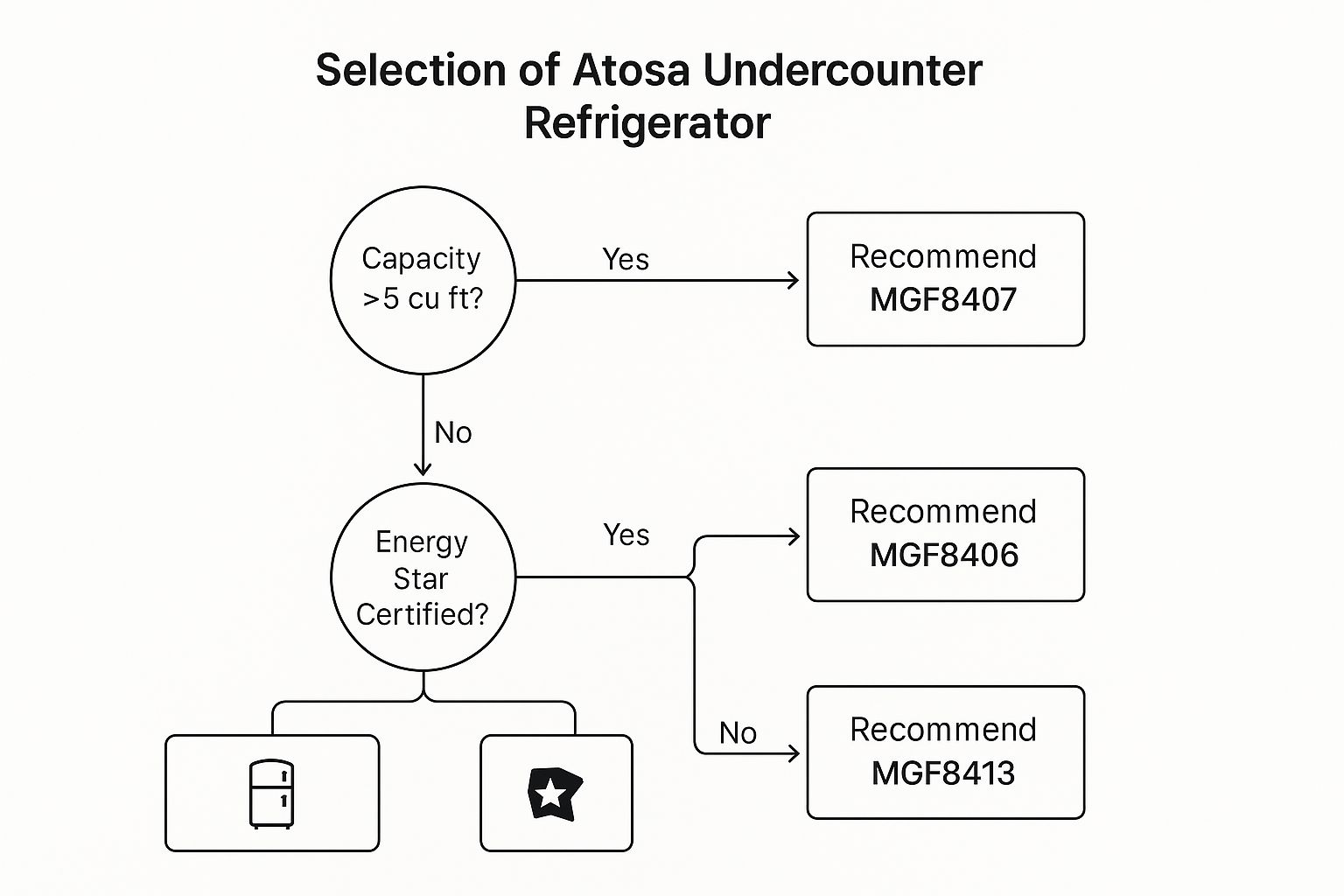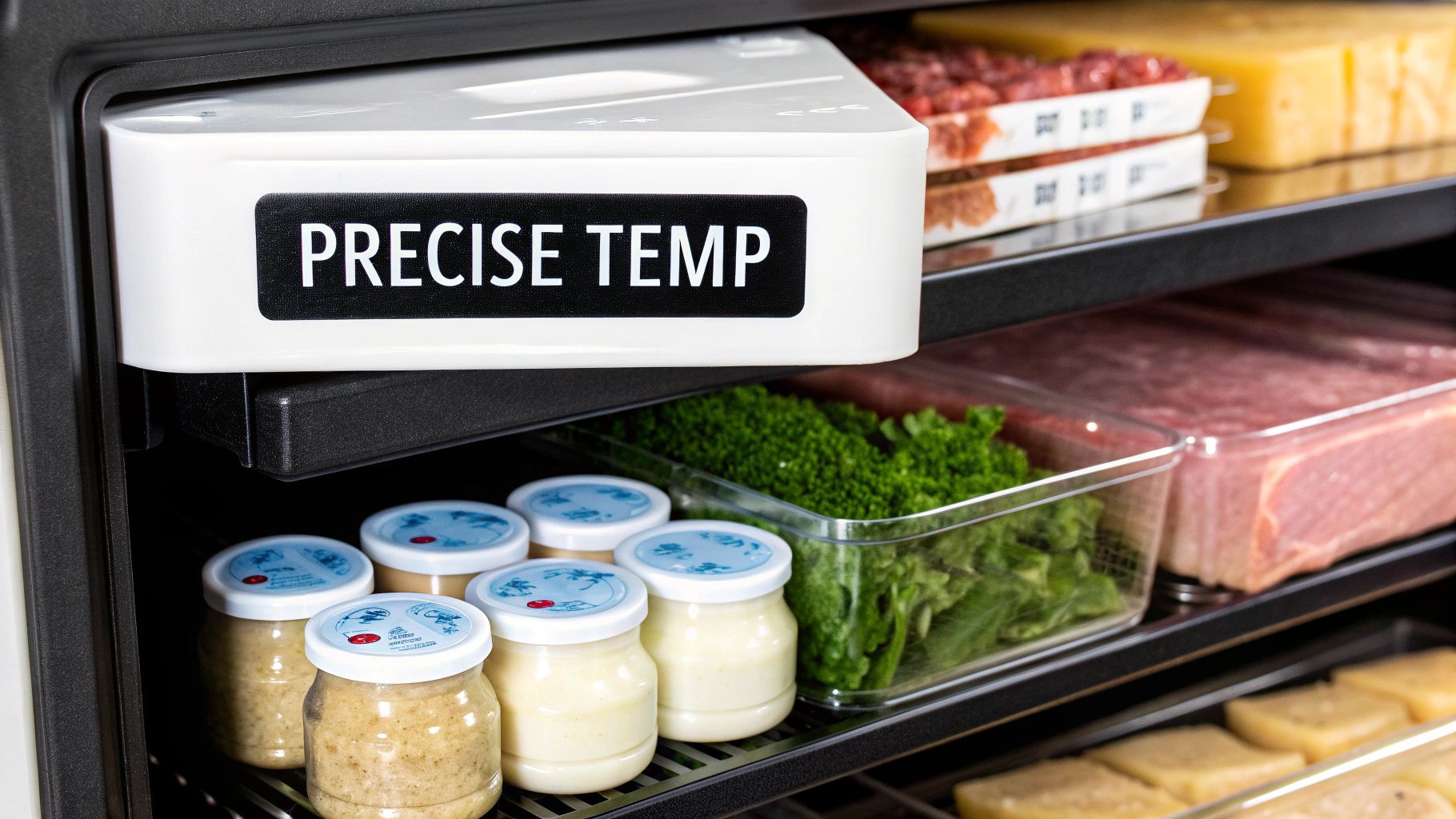
Atosa Undercounter Refrigerator Your Buying Guide
Share
In the heat of a busy commercial kitchen, every single piece of equipment has to pull its weight. It needs to be tough, reliable, and efficient. That's why so many chefs and restaurant owners I talk to swear by their Atosa undercounter refrigerators. They're built to handle the chaos of a professional kitchen and fit right into the workflow without missing a beat.
These units aren't just boxes to keep things cold; they're a smart play for better food safety and faster service. Stay tuned as we dive into what makes these units a top choice and share insights to help you stay ahead of industry trends.
Why Smart Kitchens Choose Atosa Undercounter Units
Think about any restaurant kitchen. The line between a smooth, successful service and total chaos is often drawn by the kitchen's layout and the dependability of its equipment. Every step a chef takes costs time, and every square inch of space is prime real estate. This is exactly where an Atosa undercounter refrigerator really shines, becoming a key part of a well-oiled, productive kitchen.
Atosa has earned its reputation by nailing three things: incredible durability, serious energy efficiency, and a smart, compact design that just works. It's helpful to think of it less as an appliance and more as a small, dedicated cold station you can place exactly where your team needs it. No more running back and forth to the walk-in cooler; the most important ingredients are right there, ready to go.
A Foundation of Durability and Trust
Atosa didn't become a leader in this space by accident; they earned it in the trenches of real, working kitchens. These refrigerators are built with high-grade stainless steel, so they can take the bumps, spills, and constant opening and closing that are just part of the job. This commitment to building things that last is a huge reason why so many pros put their trust in the brand.
The numbers back this up. Atosa holds an impressive 40% share of the global commercial undercounter refrigeration market, which speaks volumes about how reliable their products are. In a tough market where every inch counts and efficiency is king, that kind of dominance is a big deal. It all comes down to their focus on energy-saving tech, sturdy construction, and precise digital temperature controls. You can find more details on Atosa's market leadership over at The Restaurant Warehouse.
A reliable refrigerator isn't a luxury; it's the foundation of food safety and operational consistency. Choosing a unit that can withstand the rigors of a commercial environment protects your inventory, your team’s workflow, and your bottom line.
A Strategic Investment in Performance
At the end of the day, choosing an Atosa undercounter refrigerator is a sharp business move. It's an investment that pays you back every day through a smoother workflow, guaranteed food safety, and equipment that you can count on for years.
When you're mapping out your kitchen, it's critical to think about how each piece fits into the bigger picture. To get a full rundown, our commercial kitchen equipment checklist can walk you through all the essentials for a top-tier operation.
By bringing these units into your kitchen, you're not just adding cold storage—you're making your entire system work better. It’s that kind of forward-thinking that helps smart restaurant owners and experienced chefs get a leg up in such a demanding industry.
What's Really Under the Hood? Key Features of Atosa Refrigerators

When you glance at an Atosa undercounter refrigerator, the first thing you notice is that durable, gleaming stainless steel. But what really makes it a kitchen workhorse are the thoughtfully engineered components humming away inside. These are the specific features that deliver when you're deep in the weeds during a dinner rush.
Let's peel back the layers and see what makes these units tick. Atosa doesn't just use stainless steel on the outside; the interior is built with it, too. Don't think of this as just a pretty finish. It's more like a suit of armor for your investment, ready to shrug off the dents, spills, and constant chaos that are part of life in any busy kitchen.
The Heart of Reliable Cooling
At the very core of every Atosa undercounter refrigerator sits a heavy-duty Embraco compressor. This isn't just any part; it's the engine that drives the entire cooling system. It’s built for power and efficiency, which means it can bring the temperature back down to a safe level quickly, even when your staff is opening and closing the door constantly during service. That rapid recovery is exactly what protects your ingredients from dangerous temperature swings.
Working hand-in-hand with that powerful compressor is the Dixell digital temperature control system. This is your command center for food safety.
The Dixell system gives you a clear, easy-to-read digital display, so your team can see with a quick glance that everything is held at the perfect temperature. This isn't just about convenience—it's about the confidence that comes from knowing you're meeting health codes and slashing expensive food waste.
Features That Just Make Kitchen Life Easier
Beyond the main cooling system, a few other features work together to make these Atosa units incredibly practical. These aren't flashy gimmicks; they are real-world solutions to common kitchen headaches.
- Self-Closing Doors: A simple but brilliant feature. It stops doors from being accidentally left open, which prevents the compressor from working overtime. The result? You save a surprising amount on energy and protect your valuable inventory.
- Magnetic Door Gaskets: A tight seal is absolutely critical for efficiency. These gaskets snap shut securely, and because they're designed to be removed without any tools, deep cleaning and replacement become quick, painless jobs.
- Pre-Installed Casters: Every unit rolls out of the factory with casters already installed. This makes moving the refrigerator for cleaning or rearranging your line an absolute breeze, saving your staff's backs and a lot of time.
When you add it all up, you get a refrigerator that does more than just cool—it works smart. The efficient system helps keep your energy bills in check, while features like the self-closing doors and easy-to-clean gaskets cut down on daily frustrations for your team. It's this blend of tough materials, precise control, and practical design that makes an Atosa such a solid choice for any commercial kitchen.
How To Select The Right Atosa Refrigerator Model
Picking the right Atosa undercounter refrigerator isn't just about finding one that fits. It’s a strategic choice that needs to sync up perfectly with your kitchen's unique layout, workflow, and even your menu. Think of it this way: the right unit should feel like a seamless part of your prep line, speeding things up instead of causing frustrating delays.
Let's walk through the key things to consider so you can pick a refrigerator that truly works for you. We'll break down how to measure your space, figure out your storage needs, and match a model to the way your kitchen operates, ensuring you get a great return on your investment.
Assess Your Kitchen's Spacing And Volume
First things first, get out the tape measure and take a hard look at your kitchen. Where will this unit go? Atosa offers models in several standard widths—most commonly 27", 48", and 60"—to fit into different kitchen footprints. A small coffee shop, for instance, might only have room for a compact 27" single-door unit to hold milk and cream.
On the other hand, a bustling prep station churning out hundreds of sandwiches or salads needs something bigger. A 48" or even a 60" model gives you the space to keep all your ingredients close at hand. This simple upgrade can slash the number of trips your staff makes to the walk-in, keeping the line moving and customers happy.

This chart helps visualize how your capacity requirements and desire for an ENERGY STAR certified unit can quickly point you toward the right model series.
Choose Doors And Drawers For Your Workflow
Next, you'll need to decide between doors (solid or glass) and drawers. This choice directly affects how your team works and how much you spend on electricity. Each style has its own strengths, so think about how your staff will use the unit day-in and day-out.
- Solid Doors: These are the gold standard for insulation and energy efficiency. They are perfect for back-of-house prep areas where you don’t need to see the contents at a glance. They keep the cold in and your utility bills down.
- Glass Doors: Ideal for bars or front-of-house setups, glass doors let you see what’s inside instantly. Bartenders can grab the right bottle or garnish without hesitation, saving valuable seconds during a busy service.
- Drawers: When it comes to organization, nothing beats drawers. They are built to hold food pans full of prepped ingredients, making them a favorite for fast-paced sandwich, salad, or grill stations where quick access is everything.
A simple change in door style can have a real impact. One study on bar efficiency found that using glass-door fridges cut the time it took to grab a beverage by 15%. That means faster service and happier customers.
Choosing the right Atosa undercounter refrigerator is all about matching the unit to your kitchen's specific needs. To help you compare some popular options at a glance, we've put together this handy table. It breaks down key models by size, capacity, and configuration, so you can quickly see which one might be the best fit for your space and workflow.
Atosa Undercounter Refrigerator Model Comparison
| Model Series | Width (Inches) | Capacity (Cu. Ft.) | Door/Drawer Style | Best For |
|---|---|---|---|---|
| MGF8401 | 27.5" | 7.2 | 1 Solid Door | Small cafes, coffee stations, tight spaces |
| MGF8409 | 27.5" | 6.5 | 2 Drawers | Low-volume prep, garnish stations |
| MGF8402 | 48.2" | 13.4 | 2 Solid Doors | General prep, high-volume ingredient storage |
| MGF8410 | 48.2" | 12 | 4 Drawers | Busy sandwich or salad prep lines |
| MGF8403 | 60.2" | 15.9 | 2 Solid Doors | Large kitchens, high-capacity back-of-house |
| MGF8407GR | 48.2" | 13.4 | 2 Glass Doors | Bars, front-of-house beverage service |
By comparing these specs side-by-side, you can better visualize how each unit would function in your establishment. Whether you need a compact workhorse or a high-capacity prep station, there's an Atosa model designed for the job.
Match The Unit To Its Job
Finally, what's the primary job this refrigerator will be doing? Is it just for cold storage, or do you need it to double as a work surface? Atosa makes different designs for these exact needs, and you can see even more choices in our guide covering the full Atosa Refrigerator line.
A standard undercounter model is designed to slide neatly under an existing counter. A worktop refrigerator, however, comes with a sturdy stainless steel top, giving you both cold storage and a food-safe prep space in one footprint. For the ultimate all-in-one station, a chef base is a low-profile, heavy-duty unit made to hold cooking equipment like griddles right on top, with refrigerated drawers below for instant access to ingredients.
By thinking through these factors—space, workflow, and function—you can confidently pick the perfect Atosa model that will help streamline your kitchen for years to come.
Where Atosa Fits in the Commercial Kitchen World

To really get why a piece of equipment is a game-changer, you have to look at the bigger picture. Picking an Atosa undercounter refrigerator isn't just buying another cooler; it's a strategic decision that positions your kitchen to take advantage of the big shifts happening across the entire foodservice industry. Once you see these market forces, you’ll understand why it's such a smart investment.
Let's be honest, the need for solid, dependable undercounter refrigeration is only going up. That makes perfect sense when you look at current industry trends. We've got a boom in fast-casual spots, the explosion of ghost kitchens, and the fact that neighborhood cafes and bars are as popular as ever. What do they all have in common? They need to make every square inch of their kitchen count while keeping ingredients perfectly fresh and safe.
The Big Trends Shaking Up Refrigeration
A few key trends are really steering the commercial refrigeration market right now. The biggest one, without a doubt, is the industry-wide obsession with energy efficiency. Every restaurant owner I know is watching their utility bills like a hawk, and manufacturers have stepped up. They’re building units that use way less power but still deliver the cooling performance you need.
Another huge shift is the move toward eco-friendly refrigerants. The old stuff is being phased out because it's rough on the environment. Modern units, including those from Atosa, have switched to alternatives like R290 hydrocarbon refrigerant. It's a natural, non-toxic gas with a super low Global Warming Potential (GWP), making it a choice you can feel good about for both your bottom line and the planet.
The commercial undercounter and worktop refrigeration market is projected to grow from USD 12.16 million in 2025 to USD 16.19 million by 2035. This isn't just random growth; it's driven by the real-world need for better efficiency and food safety in kitchens, plus new tech like smart cooling systems and digital controls. You can dig deeper into these numbers over at Future Market Insights.
How Tech Is Making Coolers Smarter
Technology is also playing a massive role. The jump to digital controls and "smart" features is quickly becoming the new normal, not a luxury. These tools give chefs and managers pinpoint control over temperature, which is absolutely critical for nailing health inspections and, just as importantly, slashing food waste.
When you look at these industry-wide shifts, you see why choosing a modern unit is so important. An Atosa undercounter refrigerator isn't just made for today's kitchen; it's built with the future of foodservice in mind. It hits all the key points that matter most:
- Energy Efficiency: Keeps your operating costs down, month after month.
- Eco-Friendly Operation: Puts you in line with modern green standards.
- Space Optimization: Helps you get the most out of your kitchen's footprint.
- Technological Precision: Ensures your food stays safe and top-quality.
Making a smart equipment choice is really about future-proofing your kitchen. By investing in an efficient and reliable Atosa undercounter refrigerator, you’re setting your business up to succeed in a tough, fast-moving industry. For more tips on making your space work harder, take a look at our guide on commercial kitchen design and layout.
Essential Maintenance for Peak Performance

Your Atosa undercounter refrigerator is a workhorse. It's also a serious investment in your kitchen's efficiency and food safety. To make sure you get a great return on that investment for years to come, a little routine maintenance goes a long way. This isn't just another chore; it’s a smart strategy to protect your equipment, your inventory, and ultimately, your profits.
A bit of proactive care is the best defense against surprise repair bills and high energy costs. These simple steps are easy to build into your team's regular cleaning duties and will absolutely extend the life of your unit.
Keep the Condenser Coils Clean
Think of the condenser coils as the lungs of your fridge. Their job is to breathe out all the heat pulled from inside the cabinet. But in a real-world kitchen, those coils are magnets for grease, dust, and all sorts of grime. When they get clogged, the whole system has to work way harder to cool down.
That extra effort means your energy bills creep up, and you're putting a ton of stress on the compressor—the heart of the machine. Cleaning them is a quick job with a huge payoff. For most kitchens, doing this quarterly is perfect. If you're near a fryer line or in a high-grease environment, you’ll want to bump that up to monthly.
A Simple Cleaning Process:
- Disconnect Power: Safety first. Always unplug the refrigerator before you start.
- Access the Coils: The coils are usually behind a grille on the front or back. Just pop it off.
- Brush and Vacuum: Grab a stiff-bristled brush to gently knock the gunk loose. Then, use a shop vac with a brush attachment to suck it all up.
Inspect and Maintain Door Gaskets
That rubber seal around the door, the gasket, is what keeps the cold air locked in. If it’s cracked, torn, or has gone hard and brittle, you’ve got a leak. Cold air seeps out, and warm air rushes in, forcing your fridge to run nonstop just to keep up.
A bad door gasket is probably the number one reason for high energy bills and unstable temperatures in commercial refrigerators. A quick check can save you a world of headaches and keep your food safe.
Get in the habit of checking the gaskets every week. A classic trick is to close the door on a dollar bill. If you can pull it out without any drag, the seal is weak and it's time for a new gasket. The good news? On an Atosa undercounter refrigerator, these are designed to be swapped out easily without any special tools.
Promote Healthy Airflow
Finally, how you load the fridge matters more than you might think. I know it’s tempting to stuff every last inch of shelf space, but that’s one of the fastest ways to kill your unit's efficiency.
When you pack items tightly together, you block air from circulating. This creates warm spots inside the unit and makes the cooling system work overtime to compensate. It's a simple fix: train your staff to leave a little breathing room between products and away from the interior walls. This small habit ensures the cold air can get everywhere, keeping your entire inventory at a consistent, safe temperature.
Your Top Questions About Atosa Refrigerators, Answered
Investing in a major piece of equipment like an Atosa undercounter refrigerator is a big decision, and it’s natural to have a few final questions. We hear from chefs and owners all the time, so we’ve put together some straightforward answers to the most common queries to help you feel confident in your choice.
What Kind of Warranty Can I Expect?
Atosa really stands behind their equipment, and their warranty shows it. You're typically looking at a two-year parts and labor warranty that covers the entire unit right out of the box. This protects you from any manufacturing issues from day one.
On top of that, they offer an additional five-year warranty just for the compressor part. The compressor is the engine of your refrigerator, so having that long-term coverage on the most critical component offers some serious peace of mind for your investment. It’s always a good idea to confirm the exact terms with your dealer, but this is the standard you can expect.
Are Atosa Refrigerators ENERGY STAR Certified?
Yes, a great number of Atosa models are ENERGY STAR® certified, which is a huge benefit for anyone mindful of their monthly overhead. To get that little blue sticker, a refrigerator has to meet some pretty demanding energy performance standards set by the U.S. Environmental Protection Agency.
How do they pull it off? It comes down to smart engineering:
- They use high-efficiency compressors that simply draw less power.
- The R290 hydrocarbon refrigerant is environmentally friendly and highly effective.
- Top-notch polyurethane insulation does a fantastic job of keeping the cold air inside, where it belongs.
This means you get the commercial-grade cooling power you need without the punishing utility bills. It's a smart choice for your bottom line and for the environment.
Can These Units Actually Keep Up in a Hot Kitchen?
Without a doubt. In fact, that's exactly the environment they were designed to thrive in. Atosa builds their refrigerators for the tough reality of a commercial kitchen, where ambient temperatures can soar during a busy service. Their cooling systems are robust enough to hold a consistent, safe temperature inside, protecting your ingredients even when the heat is on.
To get the best performance in a hot kitchen, ventilation is everything. Give the unit a few inches of breathing room on the sides and back so air can circulate. It's also wise to avoid placing it right next to high-heat equipment like your range or fryer, which would just make the compressor work harder than it needs to.
How Often Do I Really Need to Clean the Condenser Coil?
This is probably the single most important piece of maintenance you can do. For most restaurant kitchens, a good rule of thumb is to clean the condenser coil thoroughly every 90 days.
Now, if your kitchen has a lot of grease in the air—maybe the unit is on the line near the fryers—you should bump that up to once per month. A clean coil lets the refrigerator shed heat effectively. That means lower energy bills and less strain on the compressor. It's a quick, five-minute task that can save you a fortune in potential repair costs.
Ready to discover the latest deals on a reliable and efficient cooling powerhouse for your kitchen? Encore Seattle Restaurant Equipment has a fantastic selection of Atosa undercounter refrigerators for any footprint or budget. Explore our inventory and find the perfect fit for your operation today.
